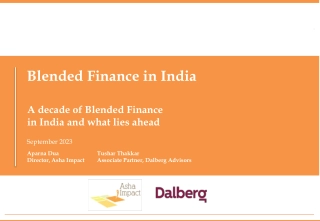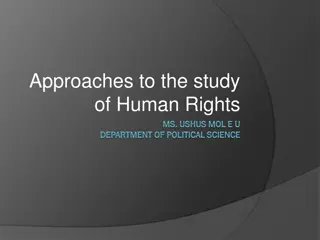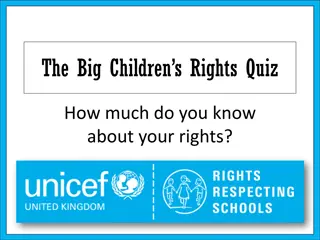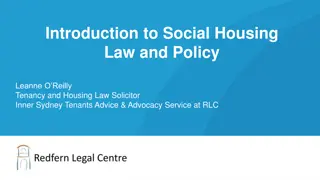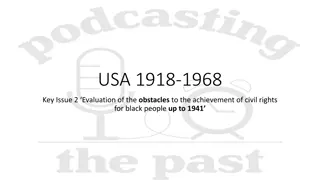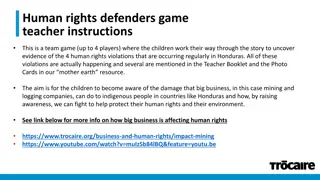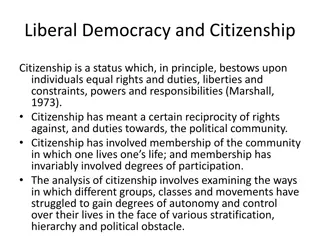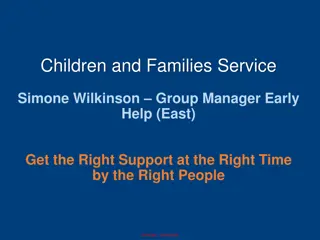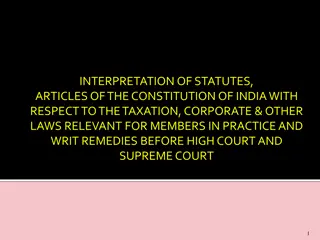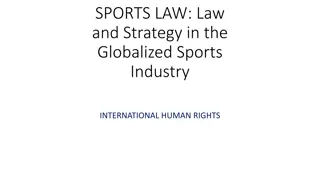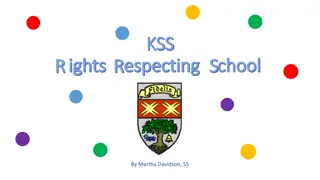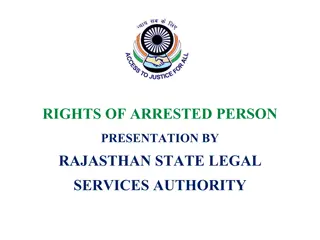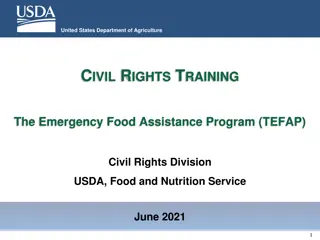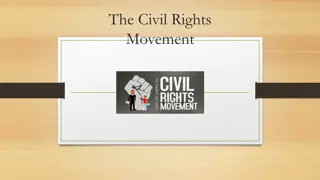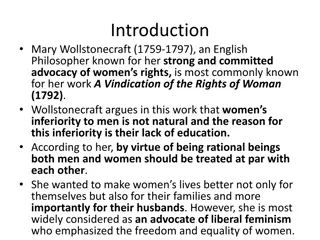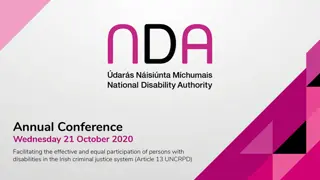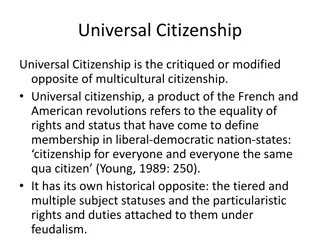Understanding Life Tenancies and Rights in Blended Families
Life tenancies and rights in blended families require careful consideration due to competing obligations. Different types of blended families like "Brady Bunch" and "Mid-life child" present unique challenges in estate planning. Addressing these complexities with proper legal guidance is crucial to ensure fair distribution among step and biological children.
Download Presentation

Please find below an Image/Link to download the presentation.
The content on the website is provided AS IS for your information and personal use only. It may not be sold, licensed, or shared on other websites without obtaining consent from the author. Download presentation by click this link. If you encounter any issues during the download, it is possible that the publisher has removed the file from their server.
E N D
Presentation Transcript
More than a Matter of Housekeeping: Life Tenancies and Rights to Reside Paul Evans Accredited Specialist Wills & Estates 1 #17588223
Blended Families Increasingly common: almost 1/4 of marriages in Australia are not the first marriage for at least one spouse A minefield of competing obligations on death! No "one size fits all" approach Three common types of blended family: "Brady Bunch" "Mid-life child" "Second relationship, adult children" Makinson d'Apice Lawyers 2
"Brady Bunch" Either or both spouses have children from a prior relationship and the children live with his/her parent and step parent Essentially the step parent treats and raises the stepchild as his/her own child Generally mirror Wills are completed giving the surviving spouse an outright gift with an equal distribution between all children (step and blood) on the survivor's death As a member of the household, a stepchild will have FPA rights under s57 Succession Act (NSW) and equivalent in other states and territories Makinson d'Apice Lawyers 3
"Mid-life child" family One or both of the couple have children from a prior relationship and have children together Meet Peter and Claire Peter has 2 children: Paul, aged 16, and Robert, aged 13, from a previous relationship. Peter pays monthly maintenance to them which ends when they complete university Peter and Claire have 2 children, Ben, aged 4, and Jane, aged 2 Peter is a CEO earning $400,000 pa but owns no assets in his sole name his first spouse received those! Makinson d'Apice Lawyers 4
"Mid-life child" family (cont.) He wishes to give Paul and Robert $1 million each and takes out life insurance of $2 million via a superannuation account as the premiums are tax deductible Peter completes a binding death benefit nomination to his estate to remove the trustee discretion His Will leaves the death benefit equally between Paul and Robert in optional testamentary discretionary trusts with each receiving 10% at 21 and the balance at 25 Makinson d'Apice Lawyers 5
"Mid-life child" family (cont.) The residue (mainly 2 investment properties owned by him as a tenant in common with Claire) passes to Claire in an optional testamentary discretionary trust with gift over to Ben and Jane in separate optional testamentary discretionary trusts Calamity clause: if none of Peter and Claire, Ben and Jane are alive, Peter and Claire leave their estate equally between Paul and Robert in separate optional testamentary discretionary trusts Makinson d'Apice Lawyers 6
"Second Relationship Adult Children" Either or both spouses have adult independent children from a prior relationship Main obligation is to provide for each other, but spouses are commonly concerned to preserve assets for their respective children & grandchildren Practitioners should advise on: life interests and rights of residence the focus of this presentation; and mutual will agreements Makinson d'Apice Lawyers 7
"Second Relationship Adult Children" (cont.) Meet Rupert and Georgia Both Rupert and Georgia have been married before. Rupert has 2 children, Sam and Ben, and Georgia has one son, David Rupert has assets worth around $4 million and Georgia assets around $3 million The only asset they own together is their home in Francis Street which they own as tenants in common in equal shares They each complete Wills leaving the children cash legacies with the residue of the estate passing to the survivor in a flexible life estate with remainder to their respective children Could have given life interest in 50% interest in Francis Street and residue to the children Makinson d'Apice Lawyers 8
Housekeeping Before You Start Drafting Who owns the house? Always undertake a title search - where property owned as joint tenants, sever the title Where the clients are living in a de facto relationship, advise will to be made in contemplation of marriage to avoid automatic revocation Remember since 9 December 2017, same-sex couples are able to marry Makinson d'Apice Lawyers 9
Characteristics of Life Interests and Rights to Reside Most common in blended families used to make provision for surviving spouse during his/her life with capital passing to testator's children (or other beneficiaries) after spouse's death Life Interest A proprietary right can be transferred, leased or mortgaged Life tenant is entitled to income and right to occupy in property but no requirement to occupy Trustees may also be empowered to distribute capital to life tenant Makinson d'Apice Lawyers 10
Characteristics of Life Interests and Rights to Reside (cont.) Can hold both real and personal property Right of Residence A right to occupy a particular property for a period of time eg 18 months from testator's death or life of beneficiary A licence a personal right governed by the document creating it The property to which it attaches cannot be sold or mortgaged No right to income Generally terminates if beneficiary moves out Makinson d'Apice Lawyers 11
Characteristics of Life Interests and Rights to Reside (cont.) In both cases, capital passes to other beneficiaries on life tenant's or beneficiary's death. These may be "remaindermen" or residuary beneficiaries Makinson d'Apice Lawyers 12
Characteristics of Life Interests and Rights to Reside (cont.) Are they adequate provision for a surviving spouse? It depends! "There is no single provision of which it may be said that a wise and just testator would have made. There is instead a range of appropriate provisions minds may legitimately differ as to the provision that should be made" per Calloway JA in Gray v Harrison [1997] 2 VR 359 at 366 "As a broad general rule the duty of the testator to his widow is, to the extent to which his assets permit him to do so, to ensure that she is secure in her home, to ensure that she has an income sufficient to permit her to live in the style to which she is accustomed, and to provide her with a fund to enable her to meet any unforeseen circumstances" Luciano v Rosenblum (1985) 2 NSWLR 65 Makinson d'Apice Lawyers 13
Characteristics of Life Interests and Rights to Reside (cont.) The standard is gender-neutral; the same applies where the surviving spouse is male - refer Justice Hallen in Jagoe v Maguire [2013] NSWSC 1283 at [137(a)] Standard in Luciano was questioned by Pembroke J in Steinmetz v Shannon [2018] NSWSC at [35]-[37]: "Claims by widows do not represent a special category deserving more favourable treatment. There is no general rule that if the size of the estate is sufficient, a widow is entitled to expect that she will be provided for in such a way that she may continue to 'live in the style to which she is accustomed': Luciano v Rosenblum (1985) 2 NSWLR 65 at 69 70. The position was stated succinctly by Sir Frederick Jordan in the Will of Gilbert (1946) 46 SR (NSW) 318 at 322 Makinson d'Apice Lawyers 14
Characteristics of Life Interests and Rights to Reside (cont.) " there is no general rule that the widow's right is in all cases paramount; although, on the facts, and in the circumstances, of particular cases, it may be proper to regard it as such. On the other hand, where, for example, the applicant is a second wife who has been married to the testator for only a short period, it may be proper, on the facts of a particular case, to take specially into account the position of the children of the first marriage . What is required, as Callaway JA explained in Grey v Harrison at 367, is 'an instinctive synthesis that takes into account all the relevant factors and gives them due weight'." Makinson d'Apice Lawyers 15
Characteristics of Life Interests and Rights to Reside (cont.) In Steinmetz, the plaintiff aged 65 was the second wife with own assets and independent income 20-year relationship, married 5 years prior to deceased's death Deceased estate $7 million under deceased's will wife received an annuity of $52,000.00, residue passed to deceased's children Pembroke J stated: "The question is not whether the annuity is fair or reasonable It is whether the provision made for the plaintiff in the deceased's will is not 'adequate' in all of the circumstances for her 'proper' maintenance or advancement in life." Makinson d'Apice Lawyers 16
Characteristics of Life Interests and Rights to Reside (cont.) However, on appeal in Steinmetz v Shannon [2019] NSWCA 114, the Court found that in the absence of competing claims, the appropriate question was: Why should the spouse of the deceased be entitled to less? On appeal, the widow was awarded $1.75m (plus her legal costs in both cases) in place of the annuity provided under the deceased s will. The Court found that the deceased had a moral duty to provide secure accommodation, amongst other things, for their spouse, for the remainder of their life. Makinson d'Apice Lawyers 17
Characteristics of Life Interests and Rights to Reside (cont.) Shift away from the concept that the needs of a spouse should reflect the accommodation that the spouse and the deceased shared during their relationship "a spouse who is to be provided with accommodation cannot always assume that they will be entitled to the accommodation that they had previously lived in, or that they will be entitled to replicate the way they anticipated living with the deceased, had the deceased lived. It may need to be factored in that what was proper accommodation for both the deceased and the spouse may be greater than is necessary for the proper maintenance and support for the spouse alone." Re Finnie; Petrovska v Morrison [2021] VSC 153 at 122 Makinson d'Apice Lawyers 18
Characteristics of Life Interests and Rights to Reside (cont.) In Bayley v Sivewright; Same v Sivewright (No. 2) [2021] NSWSC 666, the plaintiff had lived in a relationship with the deceased for 13 years He was 38 years of age and unemployed Received provision from the deceased of $1.3 million from his superannuation and life insurance. He sought an additional $1.2 million $1.37 million to purchase a home similar to the one he rented with the deceased The Court stated on "no view does he need a house of the size he currently occupies" He had a long and productive life ahead of him Makinson d'Apice Lawyers 19
Characteristics of Life Interests and Rights to Reside (cont.) Each case depends on its own facts but a spouse does not automatically have primacy over competing beneficiaries Generally a right of residence is not appropriate provision for a surviving spouse "The mere right of residence is an unsatisfactory method of providing for a spouse as, if the spouse is compelled to give up the right by, eg, sickness, he or she cannot obtain support by obtaining income from the property." Szlazko v Travini [2004] NSWSC 610 Makinson d'Apice Lawyers 20
Characteristics of Life Interests and Rights to Reside (cont.) "A mere right of residence will usually be an unsatisfactory method of providing for a spouse's accommodation This is because a spouse may be compelled by sickness, age, urgent supervening necessity or otherwise, with good reason, to leave the residence. The spouse will then be left without the kind of protection which is normally expected will be provided by a testator who is both wise and just." Golosky v Golosky [1993] NSWCA 111 However a right of residence may be appropriate in particular cases Makinson d'Apice Lawyers 21
Characteristics of Life Interests and Rights to Reside (cont.) In Lowe v Lowe (No 2) [2015] NSWSC 1626, Diana aged 82, the second wife of the deceased Relationship of 8 years married 4 years prior to the deceased's death Deceased's estate $3,300,000.00 Diana owned her own home worth $1,300,000.00 The deceased's Will gave cash gifts to his 6 grandchildren, with Diana receiving personal effects, a car and the right to reside in the matrimonial home for up to 18 months from his death, with the option to purchase the property when that period expired. Residue passed to the deceased's adult children Diana received additional provision of $100,000.00 to ensure her position was no better or worse than her circumstances at the time she began her relationship with the deceased Right to reside upheld Makinson d'Apice Lawyers 22
Characteristics of Life Interests and Rights to Reside (cont.) Meet John and Valerie Valerie's assets total $60 million including a Sydney harbour waterfront home No children of the relationship Valerie gives John the right to occupy the waterfront home for 6 months from her death to enable him to move into a second property owned by her in which she gives him a life interest. This gives him time to move etc Makinson d'Apice Lawyers 23
Characteristics of Life Interests and Rights to Reside (cont.) Generally a life interest will be upheld provided it encapsulates the provisions of "a Crisp order" (ie a portable life estate) Makinson d'Apice Lawyers 24
Characteristics of Life Interests and Rights to Reside (cont.) In O'Leary v O'Leary & Eccles [2010] NSWSC 1347, Hallen J summarised a Crisp order as follows: " an order of the kind made by Holland J in Crisp v Burns Philp Trustee Co Ltd (NSWSC, 18 December 1979, unreported) Such an order gives an applicant an interest for life in real property, or in an interest in real property, with the right to it (should the need arise) for the purposes of securing, for the applicant's benefit, more appropriate accommodation. That type of order is intended to provide flexibility, by way of a life estate, the terms of which could be changed to cover the situation of the applicant moving from her own home to retirement village to nursing home to hospital." Makinson d'Apice Lawyers 25
Characteristics of Life Interests and Rights to Reside (cont.) Thompson v Thompson [2015] VSC 706 Gwen aged 77 had been in a relationship with the deceased for over 25 years The deceased and Gwen owned an apartment in Collingwood as tenants in common in equal shares and were living there at his death Under the deceased's will, Gwen received his personal effects, $15,000.00 and a life interest in his 50% share of the apartment. The residue of the estate passed to his adult children Gwen sought an absolute interest in the deceased's 50% share of the apartment however the Court ordered further provision for her proper maintenance and support by way of a portable life interest in the apartment Makinson d'Apice Lawyers 26
Characteristics of Life Interests and Rights to Reside (cont.) Ng v Lau; In the Estate of Ken Kui Yuen Lau [2020] NSWSC 713 Mary aged 74 was the second wife of the deceased. They had been married for 17 years They owned a property in Bexley as tenants in common Under the deceased's will, Mary received a life interest in the Bexley property and 50% of the residue with the balance passing to the deceased's son Gary As the life interest was inflexible, the Court ordered she be given a portable life estate Makinson d'Apice Lawyers 27
Life Interest v Right to Reside How do you distinguish them? Lester v Lester [2018] VSC 611 "I GIVE DEVISE AND BEQUEATH all of my one half ( ) right title and interest in and to the freehold property known as [the Toorak Property] to my trustees UPON TRUST to permit my said son DAVID RICHARD PELHAM LESTER to use the same rent free during his lifetime with my said son paying all rates and taxes thereon and other outgoings thereof and keeping the same in a good and habitable state of repair fair wear and tear and damage by fire lightning Act of God inevitable accident flight and tempest expected [sic] with my said son keeping the same Makinson d'Apice Lawyers 28
Life Interest v Right to Reside How do you distinguish them? (cont.) insured to the full value thereof against fire and such other risks as my trustees may desire and to the satisfaction of my trustees and after his death TO HOLD all of my one half ( ) right title and interest in and to the [Toorak Property] to form part of my residuary estate." The word "use" gave David a life tenancy in the Toorak property and was not subject to any temporal limitations such as "for as long as the beneficiary desires". Makinson d'Apice Lawyers 29
Life Interest v Right to Reside How do you distinguish them? (cont.) Finlay v Tucker [2015] NSWSC 560 4. PROVIDED THAT I direct that my wife shall during her lifetime have the right to occupy any house being the matrimonial home of which I am seized as at the date of my death and that during her lifetime she shall not be responsible for any payments for maintenance, repairs, rates or taxes in relation to the said property and the same shall be applied out of the income from my estate AND I FURTHER DIRECT that my trustee shall have the right to sell such home being the matrimonial home as at the date of my death PROVIDED THAT another house is bought in lieu thereof for my wife s occupation. Makinson d'Apice Lawyers 30
Life Interest v Right to Reside How do you distinguish them? (cont.) "right to occupy" and "my wife's occupation" rather than "a right of residence" was sufficient to confer a life interest Makinson d'Apice Lawyers 31
Life Interest v Right to Reside How do you distinguish them? (cont.) McElligott v Public Trustee of Queensland [2013] QSC 314 Interest in Property I GIVE my house and land at 186 COLLINS ROAD NINDERRY QLD together with all my household furniture and household effects (other than motor vehicles) therein at my death ( the property ) TO my Trustee ON TRUST to permit my granddaughter TAKARLI JOY MCELLIGOTT and my grandson TARSON JAMES MCELLIGOTT both presently living at the property to have the full use of the property for a period of five years from my death TOGETHER with the full use of my household furniture and household effects as a personal right. Makinson d'Apice Lawyers 32
Life Interest v Right to Reside How do you distinguish them? (cont.) The evidence showed the testator gave the grandchildren a personal right to live in the property. It was also apparent the testator's intention was they would live on the property rather than, for example, lease it. Makinson d'Apice Lawyers 33
Life Interest v Right to Reside How do you distinguish them? (cont.) Differences between Life Estates and Rights to Reside Life Estate Term Generally, the lifetime of the beneficiary unless a condition has been breached for example, remarriage but do not include such a condition may trigger a family provision claim Right to Reside Generally: For the lifetime of the beneficiary; OR For a specified time eg 5 years from death; OR Until the beneficiary remarries or enters into a de facto relationship; OR Until the beneficiary no longer lives at the property a question of fact. Makinson d'Apice Lawyers 34
Life Interest v Right to Reside How do you distinguish them? (cont.) Differences between Life Estates and Rights to Reside Does the beneficiary have access to income? Yes, an absolute entitlement No Does the beneficiary have access to capital? Generally, no but review the terms of the Will for example, power to advance capital to the life tenant if income is insufficient/medical expenses / reimbursement of CGT No Makinson d'Apice Lawyers 35
Life Interest v Right to Reside How do you distinguish them? (cont.) Differences between Life Estates and Rights to Reside Can the beneficiary live in the property? Yes Yes Can the property be sold to purchase a new property? Generally yes, but it depends on the terms of the Will. Generally no, unless the Will allows for a substitute residence to be purchased. Makinson d'Apice Lawyers 36
Life Interest v Right to Reside How do you distinguish them? (cont.) "Use and occupy" a property points to a life estate since "use" or "occupation" may be exercised in person or through another (such as a tenant) "To reside" or "to live" on land confers a personal right only as it must be exercised in person Each case depends on its own facts! Makinson d'Apice Lawyers 37
Absolute Gift An absolute gift avoids ongoing trust Client must appreciate that his/her interest in the property and assets pass to the surviving spouse on a no-strings basis The assets will ultimately pass pursuant to the surviving spouse's Will or intestacy Always consider possible family provision claims by adult children who may be concerned the step-parent will not make provision for them Makinson d'Apice Lawyers 38
Life Interests: Drafting Issues/Conditions 1. Entitlement to income: life tenant should be entitled to income from property even if not living in property where the life tenant has dependant children include power for life tenant to consent to income distributions to them ie tax minimisation. 2.Power to advance capital: trustees should have power to advance capital to life tenant if income is insufficient to maintain life tenant or life tenant requires it for onerous expenses (eg medical). Makinson d'Apice Lawyers 39
Life Interests: Drafting Issues/Conditions (cont.) 3. Flexibility: trustees can sell property in the trust at the request of life tenant or his/her LPR and purchase substitute residence for life tenant to cater for his/her changing circumstances. Substitute residence should include freehold/strata, retirement home unit or Refundable Accommodation Deposit (RAD). The will should acknowledge a substitute residence may result in no capital growth. Makinson d'Apice Lawyers 40
Life Interests: Drafting Issues/Conditions (cont.) 4. Power to lend: to enable life tenant to acquire an interest in an aged care facility (which must be in the name of the occupant), or for payment of RAD these must be refunded to occupant or his/her estate) - Aged Care Act 1997. Generally interest free. On the life tenant's death, the loan is repaid into the trust thereby protecting capital. 5. Appropriate trustees: generally appoint life tenant with preferably 2 independent trustees (ideally person(s) with whom he/she can get along but who will remain independent are stepchildren appropriate?) 2 independent trustees avoids the life tenant controlling the trust ie if the second trustee dies/loses capacity Makinson d'Apice Lawyers 41
Life Interests: Drafting Issues/Conditions (cont.) 6. Consent of life tenant's attorney: eg if life tenant lacks capacity 7. Who pays outgoings: generally the life tenant will cover insurance and rates with trustee covering capital repairs etc if a will is silent it is generally accepted the life tenant is responsible for outgoings and general maintenance. Note that if the life tenant does not maintain the right to occupy will not terminate see Peters v Taylor [2017] NSWSC 965 Makinson d'Apice Lawyers 42
Life Interests: Drafting Issues/Conditions (cont.) 8. Fund for outgoings: irrespective of whether the life tenant or trustee is liable where the life interest includes specific real estate but not the residuary estate, include a capital sum to be invested by the trustees, to cover payment of outgoings. Avoids a dry trust and personal liability of trustees to pay outgoings ie duty to protect trust assets. 9. Capital gains tax: trustee to have power to reimburse life tenant or remainder beneficiaries for any CGT liability 10.Right of occupation: ensures private residence exemption available for CGT and land tax purposes Makinson d'Apice Lawyers 43
Life Interests: Drafting Issues/Conditions (cont.) 11.Apportionment rules: exclude in SA and Tasmania 12.Trust for sale: avoid Settled Land Act in Victoria 13.Power to vary: as the trust may last for many years, include power to vary administrative provisions to address for example changes in tax legislation 14.Household and personal items: these should be specifically given to the life tenant (if appropriate) and not pass into the trust thereby avoiding the trustee's obligation to inspect annually and maintain an inventory Makinson d'Apice Lawyers 44
Life Interests: Drafting Issues/Conditions (cont.) 15.Gift of the Principal Residence or Specific Property: Peter's will gives "my principal residence at my death to my Trustees " What issues can arise? Makinson d'Apice Lawyers 45
Life Interests: Drafting Issues/Conditions (cont.) He may be living in a nursing home but still owns his former PPR. Address by: "Principal residence" means: (a) my interest in the last residence in which I was residing prior to my death, even if I was not living in such residence immediately prior to my death (currently the property located at 10/8a Hampden Road, Pennant Hills in the State of New South Wales); and (b) excludes any interest in leasehold property or any rights I may have in a residential care facility. Peter may also have sold his PPR see next slide Makinson d'Apice Lawyers 46
Life Interests: Drafting Issues/Conditions (cont.) Peter's will provides "I give to my Executors my property known as 10 George Street " The gift will fail if the property has been sold address this by: "If the gift of my George Street Property fails because I do not own my George Street Property at my death then I GIVE to my Executors upon trust in lieu of my George Street Property a cash sum equivalent to the sale proceeds of my George Street Property calculated after deducting the costs of sale, any land tax and any capital gains tax (but excluding any Medicare levy) paid or payable on the sale of my George Street Property but disregarding any debt attaching to the subject property at the time of sale." Sale by an attorney may save the gift but beneficiary does not receive net sale proceeds but what is left of the sale proceeds at the Willmaker's death ie if the sale proceeds had been used to fund the Willmaker's living expenses Makinson d'Apice Lawyers 47
Taxation of Life Interests and Rights to Reside A minefield do not give advice but be aware of the issues Main residence tax exemptions CGT and land tax Provided the will includes the right to occupy and the life tenant or beneficiary does occupy, the CGT and land tax main residence exemptions will be available also applies to a substitute residence Makinson d'Apice Lawyers 48
Taxation of Life Interests and Rights to Reside (cont.) CGT arising due to administration of the trust As CGT main residence exemption generally available where property occupied by life tenant, CGT will only be an issue where shares or an investment property are sold by the trustee Trust capital gains are taxed under the present entitlement rules or the specific entitlement rules As a life tenant is presently entitled to income, he/she will be taxed on any capital gain but will not receive the capital gain which remains in the trust Specific entitlement trustee or beneficiary receives the capital gain and is taxed on it Makinson d'Apice Lawyers 49
Taxation of Life Interests and Rights to Reside (cont.) Choice of Income Definition for Trust Tax, ie s95 ITAA 1936 includes net capital gains Accounting (or trust law) excludes those gains As the intention of a life estate is to retain capital for the benefit of the remainder beneficiaries, the accounting or trust law definition is generally preferred If the will is silent as to which income definition applies, it is generally accepted that the accounting or trust law definition will apply If in doubt, make trustee specifically entitled must be assessed under s99, to ensure CGT 50% discount is available with the trustee being taxed at marginal rates (albeit without the benefit of the tax-free threshold). If assessed under s99A, the trustee will be taxed at the top marginal rate and the discount will not be available Makinson d'Apice Lawyers 50





